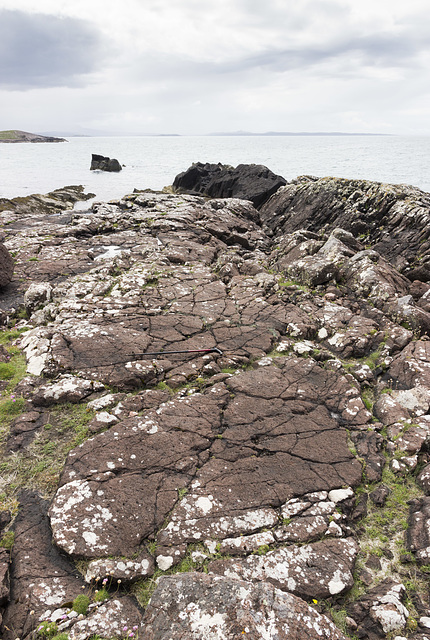Stac Fada Formation - possible cooling joints? 2
Staca Fada Formation - close up 1
Staca Fada Formation - close up 2
Staca Fada - view south
Staca Fada - view west
Meall Dubh
Meall Dubh from Meall Dubh
Pear leaves 'pleochroic halos'
Red leaves and green
Autumn colour cascades
Berries in the spotlight 1
Berries in the spotlight 2
Rainbow in the morning...
Whirlow sunset
Limb Valley trees and fields
Whirlow Park winter beech 2
Whirlow Park winter beech
Whirlow Park winter twigs and sky
Poinsettia leaf 1
Poinsettia leaf 2
Pan bottom
Marching out to sea
Radar tower and estuary
Stac Fada Formation
Bay of Stoer and Stac Fada
Bay of Stoer - north west
Bay of Stoer - bands of colour
Bay of Stoer - south west view
Handa Island - ferry landing from Port of Tarbet
Handa Island - ferry coming from Port of Tarbet
Handa Island - landing beach
Handa Island - ferry gang-plank
Handa Island - Bob and David
Handa Island - shower over Glas Leac and Stoer Pen…
Handa Island - Tràigh Shourie
Handa Island - Great Skua
Handa Island - geo at Traigh na h-Airigh 2
Handa Island - geo at Traigh na h-Airigh
Handa Island - shower and Stoer peninsula
Handa Island - Cotton grass and Sìthean Mòr
Handa Island - Great Stack geodh
Handa Island - Great Stack (2)
Handa Island - Great Stack
Handa Island - Geodh' a' Bhrisidh (2)
Handa Island - Geodh' a' Bhrisidh
1/200 • f/11.0 • 15.0 mm • ISO 200 •
Canon EOS 600D
EF-S15-85mm f/3.5-5.6 IS USM
Location
See also...
Keywords
Authorizations, license
-
Visible by: Everyone -
All rights reserved
-
335 visits
Stac Fada Formation - possible cooling joints? 1


Stac Fada at the northern end of the Bay of Stoer, north west Scotland, is the type locality for the Stac Fada Formation, recently interpreted as a meteorite impact debris horizon, comparable with suevite from the much younger (Miocene, 15 Ma) Ries meteorite impact event in south Germany. The Stac Fada Formation lies within the Bay of Stoer Formation, mostly fluviatile sandstones and siltstones (Mesoproterozoic, c. 1200 Ma).
The Stac Fada Formation is about 12 metres thick at this location. The photo shows a part of the middle section and consists of a poorly bedded arkosic sand matrix within which there are dark green chloritised clasts and fragments which represent formerly molten debris blasted into the air from the original impact. There is a network of polygonal cracks visible on this 'bedding' surface and I theorise that these may be cooling joints formed as the presumably hot ejecta deposit cooled and contracted. (I have seen no reference to this particular feature in the literature).
The site of the meteorite impact is now correlated with a well-defined, roughly circular, low-gravity anomaly some 50 km to the east, near the village of Lairg, although any impact crater is now buried beneath younger rocks. SEE UPDATE BELOW.
For more details see:
Simms, M. J., 2015. The Stac Fada impact ejecta deposit and the Lairg Gravity Low: evidence for a buried Precambrian impact crater in Scotland?, Proceedings of the Geologists Association, 126 (2015), 742 - 761.
UPDATE June 2019:
Latest research based on detailed field observations, geochemical and geomagnetic work now seems to indicate that the impact site is located in the present day Minch, about 15 - 20 km WNW of Enard Bay. See:
Amor, K. et al, 2019. The Mesoproterozoic Stac Fada proximal ejecta blanket, NW Scotland: constraints on crater location from field observations, anisotropy of magnetic susceptibility, petrography and geochemistry. Journal of the Geological Society 176/4 (2019).
dx.doi.org/10.1144/jgs2018-093
The Stac Fada Formation is about 12 metres thick at this location. The photo shows a part of the middle section and consists of a poorly bedded arkosic sand matrix within which there are dark green chloritised clasts and fragments which represent formerly molten debris blasted into the air from the original impact. There is a network of polygonal cracks visible on this 'bedding' surface and I theorise that these may be cooling joints formed as the presumably hot ejecta deposit cooled and contracted. (I have seen no reference to this particular feature in the literature).
The site of the meteorite impact is now correlated with a well-defined, roughly circular, low-gravity anomaly some 50 km to the east, near the village of Lairg, although any impact crater is now buried beneath younger rocks. SEE UPDATE BELOW.
For more details see:
Simms, M. J., 2015. The Stac Fada impact ejecta deposit and the Lairg Gravity Low: evidence for a buried Precambrian impact crater in Scotland?, Proceedings of the Geologists Association, 126 (2015), 742 - 761.
UPDATE June 2019:
Latest research based on detailed field observations, geochemical and geomagnetic work now seems to indicate that the impact site is located in the present day Minch, about 15 - 20 km WNW of Enard Bay. See:
Amor, K. et al, 2019. The Mesoproterozoic Stac Fada proximal ejecta blanket, NW Scotland: constraints on crater location from field observations, anisotropy of magnetic susceptibility, petrography and geochemistry. Journal of the Geological Society 176/4 (2019).
dx.doi.org/10.1144/jgs2018-093
- Keyboard shortcuts:
Jump to top
RSS feed- Latest comments - Subscribe to the comment feeds of this photo
- ipernity © 2007-2024
- Help & Contact
|
Club news
|
About ipernity
|
History |
ipernity Club & Prices |
Guide of good conduct
Donate | Group guidelines | Privacy policy | Terms of use | Statutes | In memoria -
Facebook
Twitter

Sign-in to write a comment.